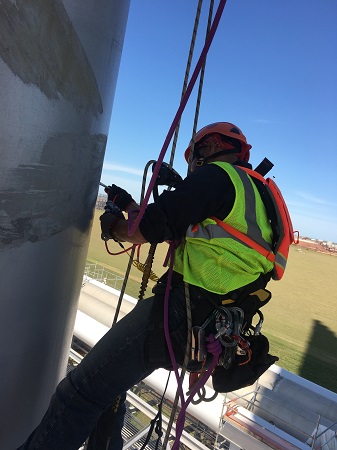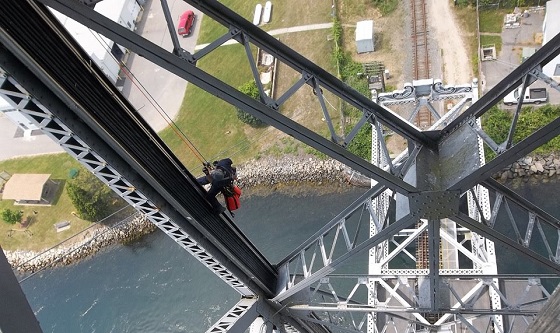Rope access technology has undergone a remarkable evolution since its inception, transforming from an experimental technique to a widely adopted and versatile method for accessing hard-to-reach areas in various industries. The genesis of rope access can be traced back to the 1980s when offshore oil and gas platforms in the North Sea faced complex maintenance tasks amid ever-changing and harsh weather conditions.
Traditional methods, such as scaffolding and cranes, proved cumbersome and impractical in these challenging environments. Seeking alternative approaches, oil companies turned to mountaineers, cavers, and rock climbers who possessed the requisite skills for working at heights and in extreme conditions. Drawing inspiration from these disciplines, the foundations of industrial rope access were established, and applications have crossed into diverse sectors, revolutionizing the way industries approach maintenance and inspection tasks, including with high-performance coatings.
Growth and Expansion
Current applications of rope access in different industries include:
1. Oil and Gas: Rope access remains a vital tool in the oil and gas industry, facilitating inspection, maintenance, and repair tasks on offshore platforms, drilling rigs, and refineries. Technicians utilize rope access methods to access complex structures, including flare stacks, pipelines, and storage tanks, ensuring the integrity and safety of these critical facilities.
2. Power Generation and Petrochemical: Rope access has become the go-to access technology for inspecting, maintaining, and repairing power stations, refineries, and storage depots. The versatility of rope access allows technicians to navigate complex structures and equipment, minimizing downtime and the risk of ignition that may be caused by conventional maintenance equipment.
3. Renewable Energy Infrastructure: As the renewable energy sector grows, rope access plays a crucial role in inspecting wind turbines, including blade inspection and repair, tower maintenance, and installation of new equipment. Rope access offers a cost-effective and efficient method for conducting inspections and ensuring the optimal performance of these vital components of the clean energy ecosystem.
4. Buildings and Structures: In the realm of modern architecture, where buildings reach unprecedented heights and incorporate intricate designs, rope access provides unparalleled access to areas that would otherwise be challenging or even impossible to reach using traditional methods. Rope access is extensively employed in building maintenance, façade inspection, window cleaning, and repair work.
5. Infrastructure and Bridges: Rope access technology has found applications in inspecting and maintaining bridges, viaducts, and other largescale infrastructure. Technicians can access hard-to-reach areas, conduct structural inspections, and carry out repairs without the need for disruptive closures or extensive equipment.
6. Shipping and Ports: Rope access is well suited for above-the-waterline inspection and maintenance of ships docked in ports. It enables efficient inspections of hulls, superstructures, and cranes, helping minimize downtime and associated costs. Rope access is also employed in the maintenance of harbor infrastructure, such as quay walls and docking facilities.
7. Confined Spaces and Industrial Facilities: Rope access technology is crucial for accessing confined spaces, such as storage tanks, silos, and access shafts, which require inspection, maintenance, and cleaning. Technicians trained in rope access techniques can work safely and efficiently in these challenging environments, ensuring compliance with safety regulations and minimizing risks.
Fundamentals of Rope Access Technology
 Rope access technology relies on a combination of specialized techniques, equipment, and safety protocols to ensure safe and efficient access to elevated, confined, or other hard-to-reach work areas. The fundamental principles of rope access include:
Rope access technology relies on a combination of specialized techniques, equipment, and safety protocols to ensure safe and efficient access to elevated, confined, or other hard-to-reach work areas. The fundamental principles of rope access include:
1. Rope Systems: Rope access systems are designed with multiple lines to ensure worker safety. A working line supports and positions the worker, while a safety line acts as a backup in the event of a failure in the working line. These systems are meticulously inspected and maintained to guarantee their integrity.
2. Rigging and Anchoring: Proper rigging and anchoring techniques are essential for creating secure attachment points and ensuring stability during rope access operations. Certified technicians are trained to assess anchor points, install rigging equipment, and calculate load capacities to guarantee safe working conditions.
3. Training and Certification: To maintain safety standards, rope access technicians undergo rigorous training and certification programs offered by organizations like the Industrial Rope Access Trade Association (IRATA) and the Society of Professional Rope Access Technicians (SPRAT). This includes extensive training in rescue techniques to retrieve workers swiftly and effectively in emergency situations.
IRATA is a professional organization involved in the development of globally applicable industrial rope access standards. In its 30-year history, IRATA membership has grown to nearly 530 rope access technology companies located around the world, employing more than 16,000 technicians and trainers. IRATA member teams have worked on landmark structures including the Eiffel Tower in Paris, the Hoover Dam on the Nevada/Arizona border, the Seattle (Washington) Space Needle, and the Burj Khalifa in Dubai (the world’s tallest building).
In addition to its rope access standards, IRATA also manages a globally recognized certification program for rope access technicians to help ensure quality and safety. IRATA offers three levels of certification:
• Level 1 certified rope access technicians are capable of performing a specified range of rope access tasks, under the supervision of a Level 3 technician. They must also log a minimum of 1,000 hours “on rope,” signed off by a Level 3, before they are eligible for Level 2.
• Level 2 certified technicians have demonstrated Level 1 skills as well as more complex rigging, rescue, and rope access skills. Level 2 technicians must work under the supervision of a Level 3 technician. They must also log, at minimum, an additional 1,000 hours “on rope,” signed off by a Level 3, before they are eligible for Level 3.
• Level 3 certified rope access technicians are capable of assuming overall responsibility for rope access safety on work projects, including the supervision of Level 1 and Level 2 technicians.
Qualifications for IRATA technician certification are based on a rigorous assessment of an applicant’s theoretical knowledge, technical skills, and workplace experience. IRATA-certified technicians are also required to recertify their credentials every three years to demonstrate their continued ability to safely perform rope access technology activities.
A separate organization called SPRAT, which is based in North America, offers comparable standards and a certification scheme for rope access technology companies and professionals. As with the IRATA rope access technician certification scheme, SPRAT technician certification is available at three levels and is based on knowledge, experience, and the successful completion of a physical performance test.
Current Uses and Advancements
In recent years, rope access technology has continued to advance, leading to innovative applications and improved efficiency in various industries. Some notable developments include:
1. Non-Destructive Testing (NDT): Rope access techniques are now integrated with non-destructive testing methods, such as guided wave, time of flight diffraction (TOFD), ultrasonic shear wave testing (UTSW), and alternating current field measurement (ACFM).
2. Specialized Maintenance: Rope access technology is increasingly utilized for specialized maintenance tasks in challenging environments. These tasks may include sign installations, flare tip change-outs, application of protective coatings on vertical surfaces, and insulation removal or repair.
3. Construction and Rigging Support: Rope access methods have proven valuable in supporting construction and rigging operations. Technicians proficient in rope access can assist with welding in hard-to-reach vertical areas, provide support during heavy rigging operations, and facilitate the movement of equipment and materials in challenging work environments.
4. Rescue Operations: Rope access technology plays a crucial role in emergency response and rescue operations. Technicians trained in rope access techniques can swiftly reach and extract workers in confined spaces, elevated structures, or inaccessible locations, ensuring the safety and well-being of personnel in critical situations.

Advancements for Years to Come
The evolution of rope access technology from its experimental beginnings to its current widespread adoption has revolutionized the way industries approach maintenance, inspection, and access to challenging work areas. The versatility, efficiency, and safety of rope access methods have made them indispensable in industries such as oil and gas, power generation, infrastructure, renewable energy, and more.
As advancements continue to be made and the training and certification of technicians become more standardized, the future of rope access looks promising. With its ability to provide cost-effective, flexible, and safe access to hard-to-reach locations, rope access technology will undoubtedly remain a vital asset in numerous industries for years to come.
Editor’s note: This article first appeared in the July 2023 print issue of CoatingsPro Magazine. Reprinted with permission.